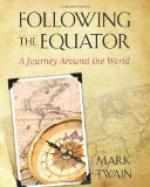The revelation came at last by accident. In a Boer’s hut out in the wide solitude of the plains, a traveling stranger noticed a child playing with a bright object, and was told it was a piece of glass which had been found in the veldt. The stranger bought it for a trifle and carried it away; and being without honor, made another stranger believe it was a diamond, and so got $125 out of him for it, and was as pleased with himself as if he had done a righteous thing. In Paris the wronged stranger sold it to a pawnshop for $10,000, who sold it to a countess for $90,000, who sold it to a brewer for $800;000, who traded it to a king for a dukedom and a pedigree, and the king “put it up the spout.” —[handwritten note: “From the Greek meaning ‘pawned it.’” M.T.]—I know these particulars to be correct.
The news flew around, and the South African diamond-boom began. The original traveler—the dishonest one—now remembered that he had once seen a Boer teamster chocking his wagon-wheel on a steep grade with a diamond as large as a football, and he laid aside his occupations and started out to hunt for it, but not with the intention of cheating anybody out of $125 with it, for he had reformed.
We now come to matters more didactic. Diamonds are not imbedded in rock ledges fifty miles long, like the Johannesburg gold, but are distributed through the rubbish of a filled-up well, so to speak. The well is rich, its walls are sharply defined; outside of the walls are no diamonds. The well is a crater, and a large one. Before it had been meddled with, its surface was even with the level plain, and there was no sign to suggest that it was there. The pasturage covering the surface of the Kimberley crater was sufficient for the support of a cow, and the pasturage underneath was sufficient for the support of a kingdom; but the cow did not know it, and lost her chance.
The Kimberley crater is roomy enough to admit the Roman Coliseum; the bottom of the crater has not been reached, and no one can tell how far down in the bowels of the earth it goes. Originally, it was a perpendicular hole packed solidly full of blue rock or cement, and scattered through that blue mass, like raisins in a pudding, were the diamonds. As deep down in the earth as the blue stuff extends, so deep will the diamonds be found.




